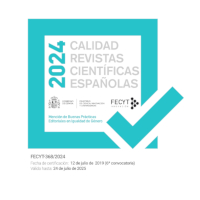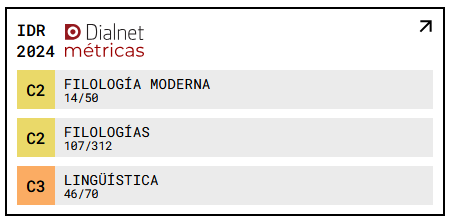Exploring Authenticity and Literary Dialect from a New Perspective
DOI:
https://doi.org/10.18172/jes.5960Keywords:
authenticity, literary dialect, literary fiction, telecinematic fiction, performed language, audienceAbstract
This paper presents a theoretical discussion of literary dialect and authenticity and proposes a new approach that will enhance our knowledge of these concepts. It reveals the existence of a gap in the study of literary dialect and authenticity, where most researchers have paid attention to the role of the writer/creator while leaving aside the reader/audience. Scholars interested in the authenticity of literary dialect have traditionally concentrated on assessing how closely literary dialects resemble real-world dialects. However, the idea that authenticity only depends on the linguistic accuracy that the writer/creator lends to the fictional portrayal of dialect has been abandoned. More recent studies have started to examine how readers/audiences authenticate (or deauthenticate) dialect representations. Their focus is on which readers/audiences evaluate a portrayal as authentic and why. This paper is in line with the view that authenticity depends on the readers’/audiences’ evaluations and suggests that the perceived authenticity of literary dialect can be measured using methods similar to those employed in language attitudes research.
Downloads
References
Agha, Asif. “The Social Life of Cultural Value.” Language and Communication, vol. 23, no. 3-4, 2003, pp. 231-273. https://doi.org/10.1016/S0271-5309(03)00012-0 DOI: https://doi.org/10.1016/S0271-5309(03)00012-0
Amador-Moreno, Carolina P. Study and analysis of the language of Patrick MacGill’s early novels. 2002. Universidad de Extremadura, PhD thesis.
Amador-Moreno, Carolina P. “How Can Corpora Be Used to Explore Literary Speech Representation?” The Routledge Handbook of Corpus Linguistics, edited by Anne O’Keeffe and Michael McCarthy, Routledge, 2010, pp. 531-544. DOI: https://doi.org/10.4324/9780203856949-38
Amador-Moreno, Carolina P., and Ana M. Terrazas-Calero. “Encapsulating Irish English in Literature.” World Englishes, vol. 36, no. 2, 2017, pp. 254-268. https://doi.org/10.1111/weng.12257 DOI: https://doi.org/10.1111/weng.12257
Amador-Moreno, Carolina P, and Kevin McCafferty. “Fictionalising Orality: An Introduction.” Sociolinguistic Studies, vol. 5, no. 1, 2011, pp. 1-13. DOI: https://doi.org/10.1558/sols.v5.i1.1
Androutsopoulos, Jannis. “Repertoires, characters and scenes: Sociolinguistic difference in Turkish-German comedy.” Multilingua, vol. 31, no. 2-3, 2012, pp. 301-326. https://doi.org/10.1515/multi-2012-0014 DOI: https://doi.org/10.1515/multi-2012-0014
Androutsopoulos, Jannis. “Participatory Culture and Metalinguistic Discourse: Performing and Negotiating German Dialects on YouTube.” Discourse 2.0: Language and new media, edited by Deborah Tannen and Anna Marie Trester, Georgetown University Press, 2013, pp. 47-71
Azevedo, Milton M. “Considerations on literary dialect in Spanish and Portuguese.” Hispania, vol. 85, no. 3, 2002, pp. 505-514. https://doi.org/10.2307/4141113 DOI: https://doi.org/10.2307/4141113
Bartley, James O. “The development of a stock character I. The stage Irishman to 1800.” The Modern Language Review, vol. 37, no. 4, 1942, pp. 438-447. https://doi.org/10.2307/3716488 DOI: https://doi.org/10.2307/3716488
Bednarek, Monika. 2011. “The language of fictional television: A case study of the ‘dramedy’ Gilmore Girls.” English Text Construction, vol. 4, no. 1, 2011, pp. 54-84. https://doi.org/10.1075/etc.4.1.04bed DOI: https://doi.org/10.1075/etc.4.1.04bed
Bell, Allan, and Andy Gibson. “Staging Language: An Introduction to the Sociolinguistics of Performance.” Journal of Sociolinguistics, vol. 15, no. 5, 2011, pp. 555-572. https://doi.org/10.1111/j.1467-9841.2011.00517.x DOI: https://doi.org/10.1111/j.1467-9841.2011.00517.x
Bell, Allan. “Language Style as Audience Design”. Language in Society, vol. 13, no. 2, 1984, pp. 145-204. https://doi.org/10.1017/S004740450001037X DOI: https://doi.org/10.1017/S004740450001037X
Blake, Norman. Non-standard language in English literature. Deutsch, 1981.
Bucholtz, Mary. “Sociolinguistic Nostalgia and the Authentication of Identity.” Journal of Sociolinguistics, vol. 7, no. 3, 2003, pp. 398-416. https://doi.org/10.1111/1467-9481.00232 DOI: https://doi.org/10.1111/1467-9481.00232
Bucholtz, Mary. “Race and the Re-embodied Voice in Hollywood Film.” Language and Communication, vol. 31, no. 3, 2011, pp. 255-265. https://doi.org/10.1016/j.langcom.2011.02.004 DOI: https://doi.org/10.1016/j.langcom.2011.02.004
Chomsky, Noam. Aspects of the Theory of Syntax. MIT Press, 1965. DOI: https://doi.org/10.21236/AD0616323
Clark, Urszula. Staging Language: Place and Identity in the Enactment, Performance and Representation of Regional Dialects. Walter de Gruyter, 2019.
Cohen Minnick, Lisa. Dialect and Dichotomy: Literary Representations of African American Speech. The University of Alabama Press, 2007.
Cooper, Paul. Enregisterment in Historical Contexts: A Framework. 2013. University of Sheffield, PhD thesis.
Coplan, Amy. “Empathic Engagement with Narrative Fictions.” The Journal of Aesthetic and Art Criticism, vol. 62, no. 2, 2004, pp. 141-152. DOI: https://doi.org/10.1111/j.1540-594X.2004.00147.x
Coupland, Nikolas. “Dialect Stylization in Radio Talk.” Language in Society, vol. 30, no. 3, 2001, pp. 345-375. https://doi.org/10.1017/S0047404501003013 DOI: https://doi.org/10.1017/S0047404501003013
Coupland, Nikolas. “Sociolinguistic Authenticities.” Journal of Sociolinguistics, vol. 7, no. 3, 2003, pp. 417-431. https://doi.org/10.1111/1467-9481.00233 DOI: https://doi.org/10.1111/1467-9481.00233
Coupland, Nikolas. Style: Language Variation and Identity. Cambridge University Press, 2007. DOI: https://doi.org/10.1017/CBO9780511755064
Coupland, Nikolas. “The Mediated Performance of Vernaculars.” Journal of English Linguistics, vol. 37, no. 3, 2009, pp. 284-300. https://doi.org/10.1177/0075424209341188 DOI: https://doi.org/10.1177/0075424209341188
Dolan, Terence P. “Samuel Beckett's dramatic use of Hiberno-English.” Irish University Review, vol. 14, no. 1, 1984, pp. 46-56.
Eckert, Penelope. “Elephants in the Room.” Journal of Sociolinguistics, vol. 7, no. 3, 2003, pp. 392-397. https://doi.org/10.1111/1467-9481.00231 DOI: https://doi.org/10.1111/1467-9481.00231
Ellis, Michael. “Literary Dialect as Linguistic Evidence: Subject-Verb Concord in Nineteenth-Century Southern Literature.” American Speech, vol. 69, no. 2, 1994, pp. 128-144. DOI: https://doi.org/10.2307/455697
Gibson, Andy. 2011. “Flight of the Conchords: Recontextualizing the voices of popular culture.” Journal of Sociolinguistics, vol. 15, no. 5, 2011, pp. 603-626. https://doi.org/10.1111/j.1467-9841.2011.00515.x DOI: https://doi.org/10.1111/j.1467-9841.2011.00515.x
Goffman, Erving. Forms of talk. Blackwell, 1981.
Hakala, Taryn. “A great man in clogs: Performing authenticity in Victorian Lancashire.” Victorian Studies, vol. 52, no. 3, 2010, pp. 387-412. https://doi.org/10.2979/vic.2010.52.3.387 DOI: https://doi.org/10.2979/vic.2010.52.3.387
Hewstone, Miles, and Giles Howard. “Social Groups and Social Stereotypes.” Sociolinguistics: A Reader and Coursebook, edited by Nikolas Coupland and Adam Jaworski, Macmillan Press 1997, pp. 270-283. DOI: https://doi.org/10.1007/978-1-349-25582-5_22
Hodson, Jane. Dialect in Film and Literature. Palgrave Macmillan, 2014. DOI: https://doi.org/10.1007/978-1-137-39394-4
Ives, Sumner. 1950. “A Theory of Literary Dialect.” Tulane Studies in English, vol. 2, 1950, pp. 137-182.
Johnstone, Barbara. “Dialect Enregisterment in Performance.” Journal of Sociolinguistics, vol. 15, no. 5, 2011, pp. 657-679. https://doi.org/10.1111/j.1467-9841.2011.00512.x DOI: https://doi.org/10.1111/j.1467-9841.2011.00512.x
Johnstone, Barbara. Speaking Pittsburghese: The Story of a Dialect. Oxford University Press, 2013. DOI: https://doi.org/10.1093/acprof:oso/9780199945689.001.0001
Johnstone, Barbara, et al. “Mobility, Indexicality, and the Enregisterment of ‘Pittsburghese.’” Journal of English linguistics, vol. 3, no. 2, 2006, pp. 77-104. https://doi.org/10.1177/0075424206290692 DOI: https://doi.org/10.1177/0075424206290692
Keen, Suzanne. “A Theory of Narrative Empathy.” Narrative, vol. 14, no. 3, 2006, pp. 207-236. DOI: https://doi.org/10.1353/nar.2006.0015
Kirk, John M. “Irish English and Contemporary Literary Writing.” Focus on Ireland, edited by Jeffrey L. Kallen, John Benjamins, 1997, pp. 189-205. DOI: https://doi.org/10.1075/veaw.g21.13kir
Koch, Peter. “Orality in Literate Cultures.” Writing Development: An Interdisciplinary View, edited by Clotilde Pontecorvo, John Benjamins, 1997, pp. 149-171. DOI: https://doi.org/10.1075/swll.6.12koc
Kozloff, Sarah. Overhearing Film Dialogue. University of California Press, 2000. DOI: https://doi.org/10.1525/9780520924024
Krapp, George P. “The Psychology of Dialect Writing.” A Various Language. Perspectives on American Dialects, edited by Juanita V. Williamson and Virginia M. Burke, Holt, Rinehart and Winston, 1971, pp. 145-177.
Labov, William. “On the Mechanism of Linguistic Change.” Sociolinguistic Patterns edited by William Labov, University of Pennsylvania Press, 1972, pp. 160-182.
Leigh, Philip. A Game of Confidence: Literary Dialect, Linguistics and Authenticity. 2011. University of Texas at Austin, PhD thesis.
Lippi-Green, Rosina. English with an Accent: Language, Ideology and Discrimination in the United States. Routledge, 2012. DOI: https://doi.org/10.4324/9780203348802
McCafferty, Kevin. “William Carleton between Irish and English: using literary dialect to study language contact and change.” Language and Literature, vol. 14, no. 4, 2005, pp. 339-362. https://doi.org/10.1177/0963947005051288 DOI: https://doi.org/10.1177/0963947005051288
Page, Norman. Speech in the English Novel. Macmillan, 1988. DOI: https://doi.org/10.1007/978-1-349-19047-8
Piazza, Roberta, et al. Telecinematic Discourse: Approaches to the Language of Films and Television Series. John Benjamins, 2011. DOI: https://doi.org/10.1075/pbns.211
Pickles, Suzanne. Post-Authenticity: Literary Dialect and Realism in Victorian and Neo-Victorian Social Novels. 2018. University of Sheffield, PhD thesis.
Planchenault, Gaelle. “Accented French in films: Performing and evaluating in-group stylisations.” Multilingua, vol. 31, no. 2-3, 2012, pp. 253-275. https://doi.org/10.1515/multi-2012-0012 DOI: https://doi.org/10.1515/multi-2012-0012
Queen, Robin. “Working with Performed Language: Movies, Television, and Music.” Data Collection in Sociolinguistics, edited by Christine Mallinson, Becky Childs and Gerard Van Herk, Routledge, 2013, pp. 233-251. DOI: https://doi.org/10.4324/9780203136065-24
Schilling-Estes, Natalie. “Investigating ‘self-conscious’ speech: The performance register in Ocracoke English”. Language in Society, vol. 27, no. 1, 1998, pp. 53-83. https://doi.org/10.1017/S0047404500019722 DOI: https://doi.org/10.1017/S0047404500019722
Schneider, Edgar W. “Investigating Variation and Change in Written Documents.” The Handbook of Language Variation and Change, edited by Jack K. Chambers, Peter Trudgill and Natalie Schilling-Estes, Blackwell, 2002, pp. 67-96. DOI: https://doi.org/10.1111/b.9781405116923.2003.00006.x
Shorrocks, Graham. “Non-Standard Dialect Literature and Popular Culture.” Speech Past and Present, Studies in English Dialectology in Memory of Ossi Ihalainen, edited by Juhani Klemola, Merja Kytö and Matti Rissanen, Peter Lang, 1996, pp. 385-405.
Silverstein, Michael. “Indexical Order and the Dialectics of Sociolinguistic Life”. Language and Communication, vol. 23, no. 3-4, 2003, pp. 193-229. https://doi.org/10.1016/S0271-5309(03)00013-2 DOI: https://doi.org/10.1016/S0271-5309(03)00013-2
Sullivan, James P. 1980. “The Validity of Literary Dialect: Evidence from the Theatrical Portrayal of Hiberno-English Forms.” Language in Society, vol. 9, no. 2, 1980, pp. 195-219. https://doi.org/10.1017/S0047404500008058 DOI: https://doi.org/10.1017/S0047404500008058
Toolan, Michael. “Significations of Representing Dialect.” Language and Literature, vol. 1, no. 1, 1992, pp. 29-46. https://doi.org/10.1177/096394709200100103 DOI: https://doi.org/10.1177/096394709200100103
Trilling, Lionel. Sincerity and Authenticity. Harvard University Press, 1972. DOI: https://doi.org/10.4159/9780674044463
Van Leeuwen, Theo. “What is Authenticity?” Discourse Studies, vol. 3, no. 4, 2001, pp. 392-397. DOI: https://doi.org/10.1177/1461445601003004003
Vaughan, Elaine, and Máiréad Moriarty. “Voicing the ‘Knacker’: Analysing the Comedy of the Rubberbandits.” Voice and Discourse in the Irish Context, edited by Carolina P. Amador-Moreno, Manuel Sánchez García, and Diana Villanueva Romero, Palgrave Macmillan, 2018, pp. 13-45. DOI: https://doi.org/10.1007/978-3-319-66029-5_2
Walshe, Shane. Irish English as Represented in Film. Peter Lang, 2009.
West, Laura, and Anna M. Trester. “Facework on Facebook”. Discourse 2.0: Language and new media, edited by Deborah Tannen and Anna M. Trester, Georgetown University Press, 2013, pp. 133-154.
Zappavigna, Michele. 2011. “Ambient Affiliation: A Linguistic Perspective on Twiter.” New Media and Society, vol. 13, no. 5, 2011, pp. 788-806. https://doi.org/10.1177/1461444810385097 DOI: https://doi.org/10.1177/1461444810385097
Downloads
Published
How to Cite
Issue
Section
License
Copyright (c) 2025 Sara Díaz-Sierra

This work is licensed under a Creative Commons Attribution 4.0 International License.
The authors retain copyright of articles and authorize Journal of English Studies the first publication. They are free to share, redistribute, and/or reprint the article without obtaining permission from the publisher as long as they give appropriate credit to the editor and the journal.
Self-archiving is allowed too. In fact, it is recommendable to deposit a PDF version of the paper in academic and/or institutional repositories.
It is recommended to include the DOI number.
This journal is licensed under a Creative Commons Attribution 4.0 International License













